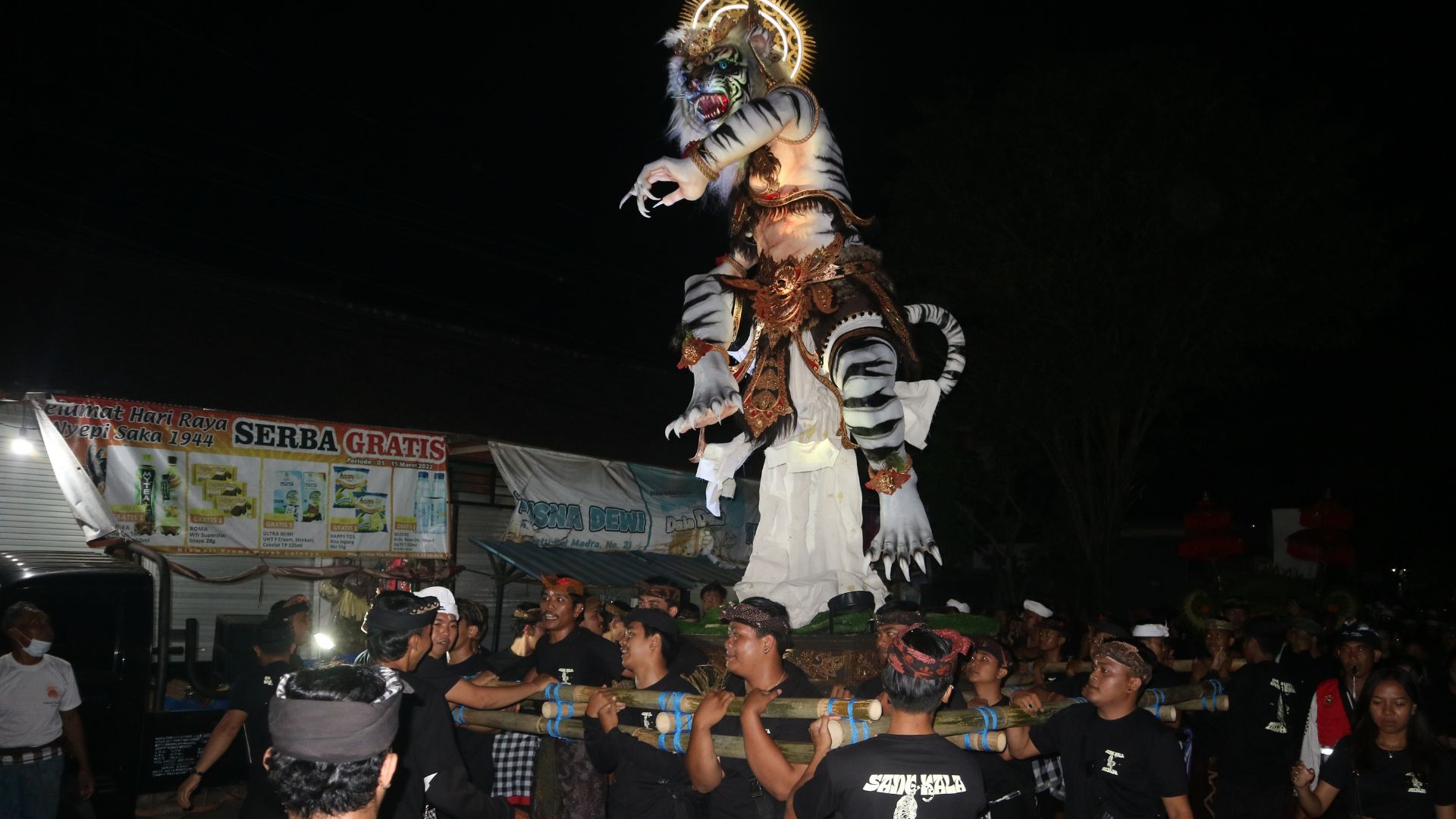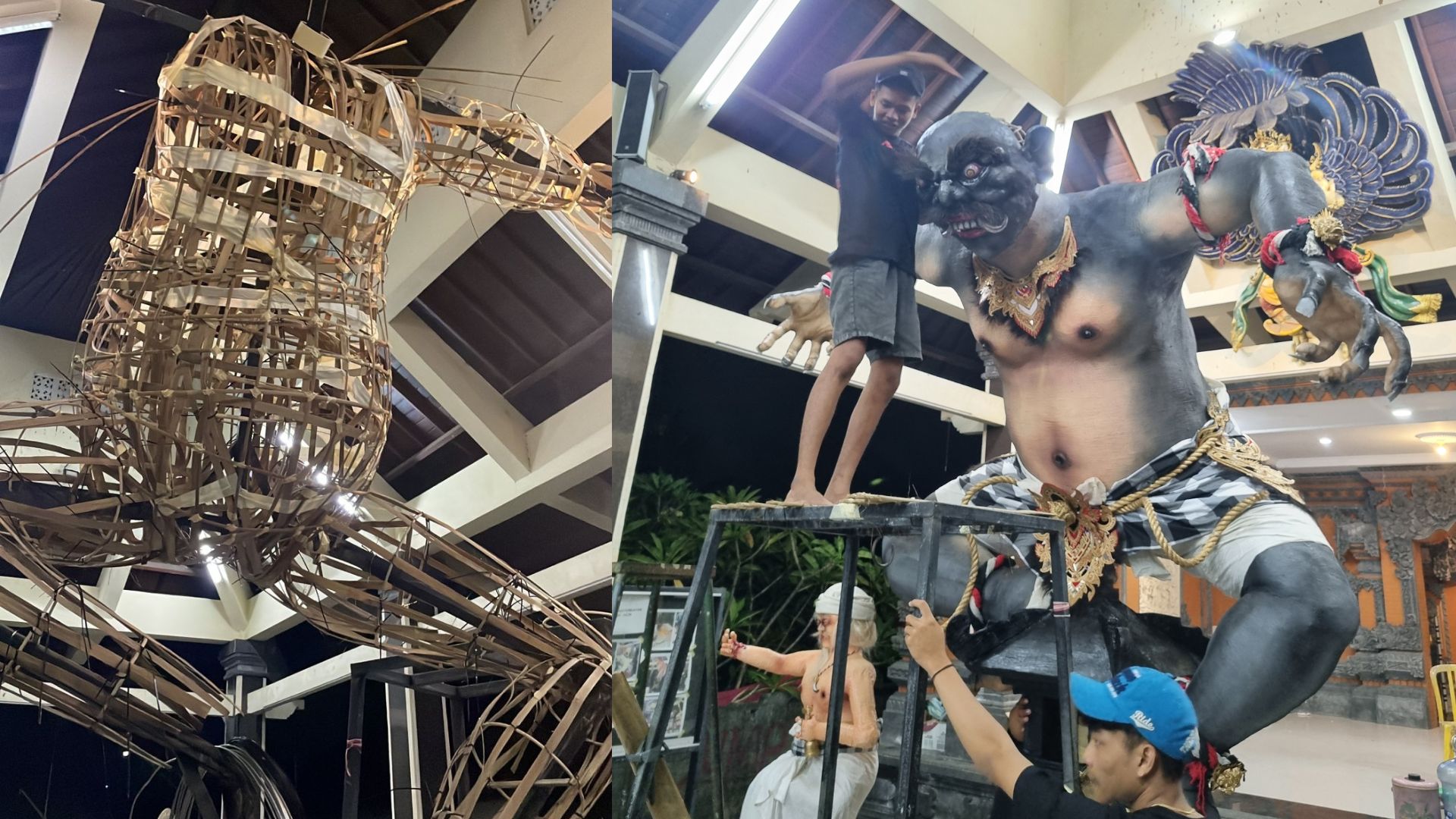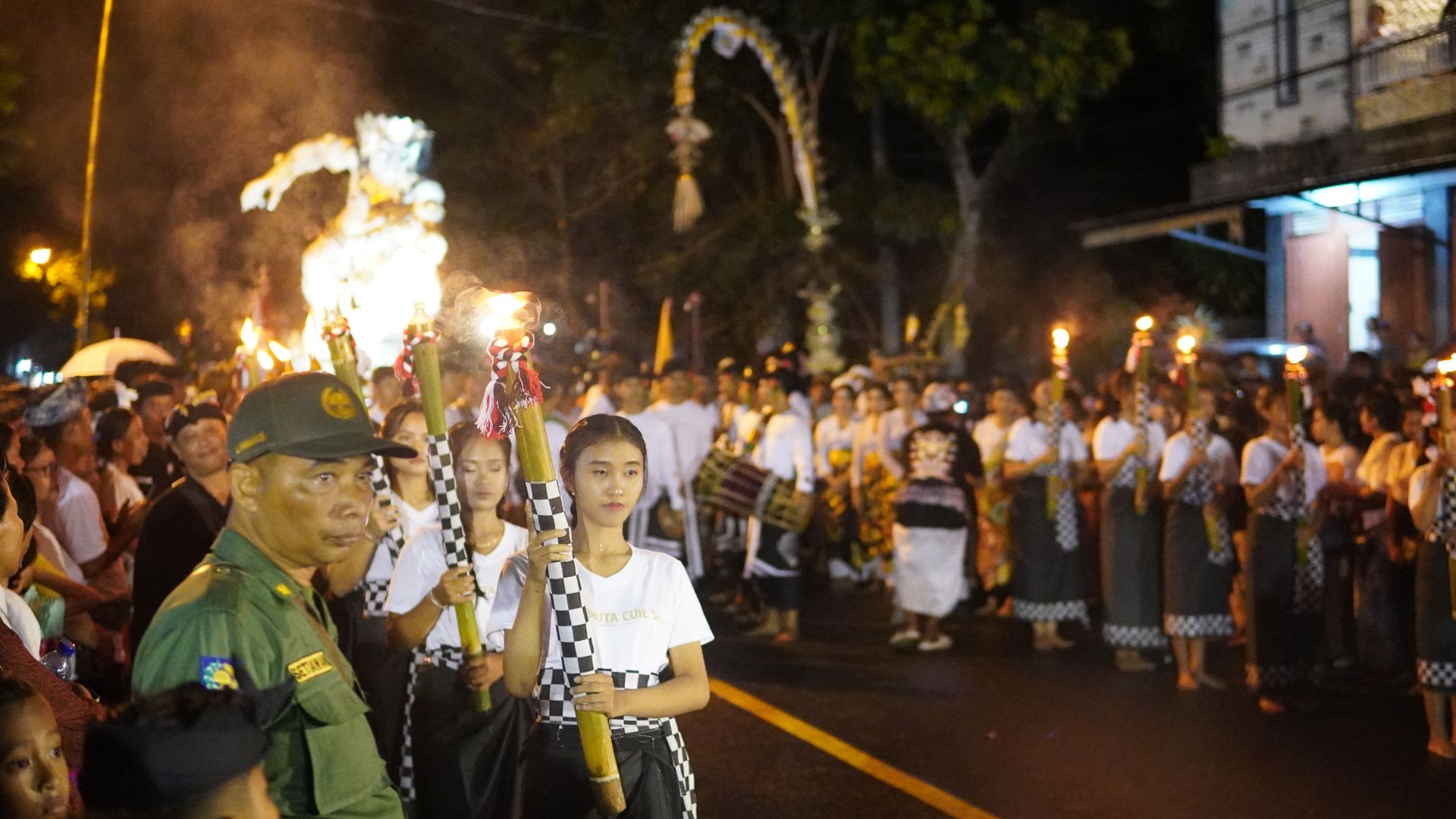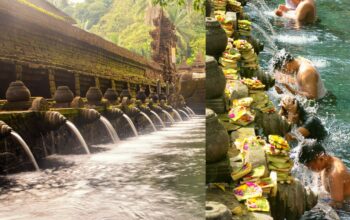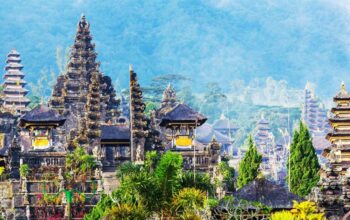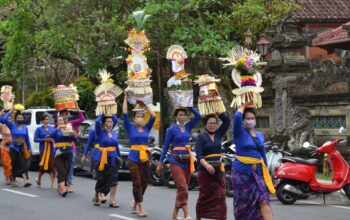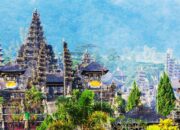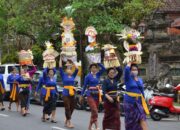Common Questions about Ogoh-Ogoh
What is Ogoh-Ogoh?
If you’ve ever been to Bali around the time of Nyepi, you’ve probably seen giant, eerie-looking effigies paraded around villages. These are called Ogoh-Ogoh. Ogoh-Ogoh are large statues made from bamboo, paper, and styrofoam, typically resembling frightening creatures like giants or Balinese mythological figures. These statues are more than just decorations; they hold symbolic meaning as representations of evil or negative aspects present in the world and within human beings.
When are Ogoh-Ogoh typically made and paraded?
Ogoh-Ogoh creation usually begins about one to two months before Nyepi. If you visit Bali during this time, you’ll often see young people busy working on Ogoh-Ogoh together at community halls (balai banjar) or on the side of the road. The creation process takes time because, besides their large size, the details are meticulously crafted to make them appear fierce and impressive. Ogoh-Ogoh are paraded around villages on the night before Nyepi, known as Pengerupukan night. This night is very lively, accompanied by the festive sound of gamelan baleganjur music.
What is the purpose of making Ogoh-Ogoh?
Why are Ogoh-Ogoh made? Ogoh-Ogoh are not just for fun or mere decoration; they have a deeper meaning. They are created as a symbol to remind people to stay away from bad traits and negative desires. When paraded and eventually burned or destroyed, it symbolizes the community symbolically expelling or discarding negative things from their environment and themselves. Therefore, Ogoh-Ogoh are part of the Balinese Hindu community’s way of purifying themselves and the universe before observing Nyepi, a day of silence, introspection, and calming the heart.
Who is involved in the Ogoh-Ogoh making process?
Regarding who makes Ogoh-Ogoh, it’s typically a communal effort by the residents of a banjar (hamlet). The most enthusiastic participants are usually the youth, especially members of the sekaa teruna (youth organization in the village). They are usually the main drivers of Ogoh-Ogoh creation, from design to assembly. However, children, adults, and even elders sometimes help, for example, by assisting with certain parts, contributing ideas, or simply offering encouragement and refreshments to those working. Essentially, Ogoh-Ogoh creation becomes a communal activity that strengthens bonds among residents.
Meaning & Philosophy of Ogoh-Ogoh
The symbolic meaning of Ogoh-Ogoh in Balinese culture
Ogoh-Ogoh are not just large statues made for entertainment. Behind their magnificent and sometimes chilling appearance, Ogoh-Ogoh hold profound meaning in Balinese culture. They symbolize all bad traits, evil energy, and all negative things in this world, including those within ourselves. By creating and then “destroying” Ogoh-Ogoh during the ceremony, Balinese people believe they are purifying themselves and their environment from these negative influences. So, in essence, Ogoh-Ogoh symbolize an invitation for us to continuously strive to be better people and maintain harmony with our surroundings.
Why are Ogoh-Ogoh usually frightening or giant in form?
Have you ever wondered why Ogoh-Ogoh often have strange, fierce, or giant forms? This is because Ogoh-Ogoh are deliberately made to look terrifying to depict evil supernatural beings or negative human traits that must be eliminated. Their scary appearance is meant to make us realize that in life, there is a dark side that we must fight. Sometimes, Ogoh-Ogoh are made to resemble characters from Balinese mythological stories known for their evil nature. However, nowadays, many are more creative, making Ogoh-Ogoh more artistic, even humorous or critical of social issues.
The relationship between Ogoh-Ogoh and Nyepi Day
Ogoh-Ogoh cannot be separated from Nyepi Day. On the night before Nyepi, known as Pengerupukan night, Ogoh-Ogoh are paraded around villages accompanied by traditional Balinese music, creating a very lively atmosphere. After being paraded, Ogoh-Ogoh are usually burned or destroyed, symbolizing that all evil and negative auras have been “erased” from the environment. The next day, on Nyepi Day, everyone observes silence, there are no activities, lights are turned off, and the atmosphere becomes quiet. This is done to perfect the cleansed atmosphere and provide a moment for self-reflection and maintaining natural balance.
Ogoh-Ogoh Making Process
Materials for making Ogoh-Ogoh
When talking about Ogoh-Ogoh, the first thing that comes to mind is usually a large, scary or unique-looking statue. To make Ogoh-Ogoh, the main materials are actually quite simple and easy to find locally. Typically, the frame of the Ogoh-Ogoh is made from bamboo because it is strong yet light, making it easy to parade around. The outer parts are shaped using paper, cloth, or sometimes styrofoam to make it easier to form detailed faces, hands, or other body parts. To make them even more impressive, Ogoh-Ogoh are usually painted in various colors and given additional accessories, such as hair made from ijuk (palm fibers) or fabric that flutters when paraded.
How long does it take to make one Ogoh-Ogoh?
The time it takes to make an Ogoh-Ogoh really depends on its size and the complexity of the design. If the Ogoh-Ogoh is large and has many details, it can take over a month to complete. Usually, the youth in the banjar start working on Ogoh-Ogoh about one or two months before Nyepi. They work on it in installments, little by little, every afternoon or evening after work or school. But if the Ogoh-Ogoh is small or the design is not too complicated, it can be finished faster. Essentially, it requires time, effort, and patience for the final result to be truly captivating when paraded.
Is Ogoh-Ogoh made individually or communally?
Regarding who makes them, Ogoh-Ogoh are almost always made communally, or through gotong royong (mutual cooperation). It’s rare for someone to make one alone, as they are large and the process is quite complex. Usually, the youth in the banjar, or those who are members of sekaa teruna groups, are the main drivers of Ogoh-Ogoh creation. They will work together from making the frame, shaping it, to painting it. Sometimes, adult residents and children also help, for example, by providing ideas, donating materials, or simply accompanying to boost morale. So, the creation of Ogoh-Ogoh is not just about making a statue, but also a moment of community togetherness.
Performance & Tradition
Where can I watch the Ogoh-Ogoh parade in Bali?
If you are on holiday in Bali leading up to Nyepi, don’t miss watching the Ogoh-Ogoh parade. This parade is usually held in almost all traditional villages in Bali. So, wherever you stay—whether in Kuta, Seminyak, Ubud, Sanur, or Canggu—there will definitely be an Ogoh-Ogoh parade nearby. However, if you want to see the liveliest and most festive atmosphere, you can look for information in larger cities like Denpasar or Gianyar. Usually, the Ogoh-Ogoh parades there are grander and take place on main roads, making them very exciting!
Are tourists allowed to participate in the Ogoh-Ogoh parade?
Actually, the Ogoh-Ogoh parade is part of a traditional ritual, so typically those directly involved in parading them are local residents, especially the youth of the banjar. However, tourists are very welcome to watch and experience the lively atmosphere. Some tourist destinations or traditional villages sometimes offer opportunities for tourists to help carry small Ogoh-Ogoh or simply join the procession. But make sure you have obtained permission from the committee or residents, so you don’t make any missteps and always respect local customs.
Are there any special rules for the Ogoh-Ogoh parade?
Of course, even though the Ogoh-Ogoh parade looks very festive, there are rules that must be followed to ensure the event runs smoothly and safely. For example, participants in the parade are not allowed to be drunk or cause disturbances that could disrupt the ceremony. Ogoh-Ogoh must also usually follow a predetermined route and are not allowed to enter temple areas indiscriminately. In addition, spectators—including tourists—are expected not to obstruct the parade route and should maintain polite behavior, such as not climbing on the Ogoh-Ogoh or touching them without permission. The essence is that the Ogoh-Ogoh parade is not just an exciting spectacle, but also a part of a sacred ritual that must be respected.
Questions about the Environment
How are modern Ogoh-Ogoh more environmentally friendly?
While in the past Ogoh-Ogoh were often made from materials that were difficult for nature to decompose, like styrofoam and chemical-based paints, now more and more people are becoming environmentally conscious. Many youth groups and villagers intentionally choose natural materials to make Ogoh-Ogoh. For example, they use bamboo for the frame, recycled paper, used cloth, and even more environmentally friendly glues. In addition, the paints used are also starting to be replaced with types that do not harm nature. So, not only are the Ogoh-Ogoh still cool and artistic, but their waste also doesn’t cause problems for the environment after the event.
What happens after the Ogoh-Ogoh parade?
After the Ogoh-Ogoh are paraded around the village on Pengerupukan night, usually two things happen. Most commonly, the Ogoh-Ogoh are burned completely. This symbolizes that all bad things, evil energy, and negative traits have been destroyed. Besides being burned, some Ogoh-Ogoh are also dismantled or taken apart so that their components can be recycled or reused, for example, the wood for fuel or the bamboo for other purposes. So, Ogoh-Ogoh are not just scary and festive; they also conclude in a wise way so as not to leave indiscriminate waste.
Conclusion
Ogoh-Ogoh are more than just large statues paraded around villages before Nyepi. Behind their scary and magnificent forms, Ogoh-Ogoh hold deep meaning as a symbol of expelling evil energy and negative traits from the environment and ourselves. From the communal process of their creation to the increasingly environmentally friendly materials used, everything shows that this tradition is not just about entertainment, but also about maintaining harmony with nature and each other. After being paraded, Ogoh-Ogoh are usually burned or dismantled so they don’t become troublesome waste. Essentially, Ogoh-Ogoh are one of the unique ways the Balinese community purifies themselves, protects the environment, and strengthens togetherness.
